Best oven for breadbaking
We are getting into baking our own bread. We have a local organic bakery that makes a great bread we all love. I bought it from them regularly, but recently their slicer broke for a time. I started preferring my loaves unsliced, and then I realized that one of the big impediments to using only home baked bread (convenience of slices), was gone. Plus my girls like to make it.
I googled the ingredient list and it appears that the bread they are selling is the recipe below. I made two loaves using the recipe, but it was a little too yeasty and a tad blah.
A few questions
1. I think I know why it was too yeasty - i always punched down dough so i did with this even thought the recipe doesnt say to
2. If you wanted it just a tad sweeter (a tad; it is not a sweet bread), would you add sugar (what will that do for yeast growth?) or honey or more raisins?
3, If you wanted it with a bit more salt, do you think that could upset the balance and bread chemistry?
4 I have a warming oven, a gas oven, and an electric. Where would you proof? At what temp? Where would you bake the loaves?
Lastly, I googled this recipe to see if other people had comments about making this particular bread. I found a much more elaborate version. (link below). Do you think its worth it to make this recipe the elaborate way?
TIA
http://fortunavirilis.blogspot.com/2009/06/peter-reinharts-power-bread.html
Here is a link that might be useful: bread recipe
Comments (40)
mtnrdredux_gw
Original Author12 years agolast modified: 9 years agoThanks, Rhome.
I have made bread before and always wondered why people think it is so difficult. I guess ok bread is easy to make, but trying to copy this artisanal bread we like may be trickier!
I knew sugar encouraged yeast, but if salt retards it, adding a bit more of both may be perfect. : )
I have seen other places where people say go by the dough, not the directions. Ive also read that doubling isnt really doubling and punching doesn't mean punching! How do you know when the dough is ready?
I think they are both Reinhart recipes, but one person took a shortcut. I am intrigued now and I am going to try the more complex method.
Related Professionals
Everett Kitchen & Bathroom Designers · Southampton Kitchen & Bathroom Designers · Williamstown Kitchen & Bathroom Designers · Forest Hill Kitchen & Bathroom Remodelers · Centerville Kitchen & Bathroom Remodelers · Kendale Lakes Kitchen & Bathroom Remodelers · Martha Lake Kitchen & Bathroom Remodelers · South Plainfield Kitchen & Bathroom Remodelers · Westchester Kitchen & Bathroom Remodelers · Alafaya Cabinets & Cabinetry · Beaumont Cabinets & Cabinetry · Forest Hills Cabinets & Cabinetry · Maywood Cabinets & Cabinetry · Edwards Tile and Stone Contractors · Riverdale Design-Build Firmsplllog
12 years agolast modified: 9 years agoNomenclature: Proofing means seeing if your yeast is alive. You can do this in a measuring cup before you start your dough by putting the yeast in with some warm water and a little sugar or flour to feed it, and set it somewhere gently warm--I like on top of the cable box (people used to do it over the pilot light on their stoves). It's not really necessary with commercial dry yeast, however, unless it's been sitting around for a long time. I can't remember the last time I had dead yeast. Commercial bakeries don't bother with this step, and just throw the yeast in the dough, and the bread shaped dough in a warm box called a "proofer" to see if it'll rise. If it does, they bake it as risen. As you can see, there's no punch down in this process because it goes right from dough to shape before rising.
So... where does the dough rise? If it's not going to rise high enough to hit the top of your warming drawer, and your kitchen is cold, that's a good option if your low setting is below 100 degrees. Similarly, if you have a setting for it on one of your ovens you can use that. The easy way is to run a big load of towels then put them on the timed dry in your dryer and set your bread bowl on top of that. It gets pleasantly warm there, and you have the benefit of the timer. :) You can also put your bowl in a cooling oven if you don't have a setting for dough. Heat it up to its low setting and turn it off. When it no longer feels hot on your hand--you don't want to kill the yeast!--put your bowl in. If this is all too complicated, find a put that your bread bowl sits in nicely, leaving at least three or four inches underneath. Put that much water in it and bring it to a boil and turn it off. After the water has settled down, and the air over it is just pleasantly warm, put your bowl on top. Maybe wrap an extra towel around the pot, besides the one covering your dough, to keep the pot warm if your kitchen is really cold.
Sugar will feed the yeast and make it happy. If your recipe is already too yeasty, perhaps too happy? You'll need to experiment. Honey is sugar. Raisins probably wouldn't affect the yeast as fast.
It only takes a tiny bit of salt to make something taste salty. Baking to a recipe is a precision thing. Baking in general is more forgiving. If you add a little bit of salt, you'll still have bread. You might find that you need to make other adjustments to get just the right rise time, texture, etc., but if you just let it do it's thing, it should be fine. You can also try adding some "decorative" salt to the crust just as you're putting it in the oven.
Baking: Electric ovens are generally more precise than gas, and electric with convection tends to be more even throughout. Gas ovens tend to be moister inside unless you add moisture to your electric oven. If you want crusty crispy, you need a moister environment (gas or electric with a pan of water). For a tender crust, it doesn't matter much. In a gas oven with no convection, you might have to rearrange your loaves partway through.
Try one loaf in each oven and see how you like it. Ovens are so different! You can always compensate once you're really familiar with the recipe, but since you have both ovens, you might as well experiment. :)
annachosaknj6b
12 years agolast modified: 9 years ago1. Did you use instant yeast? Try regular yeast instead. You might need to let it rise a bit longer.
2. You can try increasing the honey up to 1/4 cup or just add little sugar. It won't hurt anything.
3. You can also increase the salt. Try increasing it to 2 tsps. If that doesn't work, add a little more. Salt can retard the yeast a bit, but let it rise longer to compensate.
4. If you can set your warming oven to 80 degrees, that should work. Just don't use a metal bowl, which will get too hot. Room temperature will work too. You could also try leaving it overnight in the fridge to develop more flavor and then let it come to room temp and rise before baking. I haven't found much difference between gas and electric for baking bread.Should you try the Reinart recipe? Absolutely, if you want a bread that's more artisanal quality, which you can only get with that sort of starter, whether it's called a biga, poolish, or chef levain. The longer period of time allows it to ferment and develop flavors like a sourdough--only you're going to bake it before it reaches that stage of tanginess. Also use a baking stone if you have one, and don't forget to use a pan at the bottom for steam, which is what gives you the crusty outside.
mtnrdredux_gw
Original Author12 years agolast modified: 9 years agoPllog and Anna,
I did not use instant yeast, having an aversion to that adjective in cooking. So I did add water and sugar and got the fun bubbling. I believe punching it down made it too yeasty so, though my girls will miss that part, we will forego.
I'm glad to hear that I can probably fiddle with sweet and salt with relative impunity. Love the idea of salt on top; that may make it seem even saltier than it actually is.
I like crust and the loaf we get at our bakery is crusty, so thanks for those pointers.
I am off to get started on the multi-day Reinhart recipe ...
annachosaknj6b
12 years agolast modified: 9 years agoNot 100% sure, but I don't think punching it down would make it taste yeastier. What kind of yeast did you use?
For the Reinart recipe, since you're developing the dough by natural fermentation and don't want to lose all the lovely bubbles and holes, gently fold the final dough to deflate instead of punching.
remodelfla
12 years agolast modified: 9 years agoI agree that though a science; I find bread baking more forgiving then I orginally thought. I have proofed on my granite counter outside when it's warm enough, in the oven on my proof setting, or in the smaller oven on low low temp. All worked fine. As I get more experienced; I'm finding that I can "feel" when the dough is ready. MOstly, after initial kneading, it's about leaving it be for at least a couple of hours, stretch and fold a bit, and leave it be again. My best breads (not the artisanal kind) came from doughs that just had a soft pliability to them. I've made up some of my own recipes and figure... why not, lets see what happens... I'm gonna use these apricots or whatever up. Some were huge successes and some pretty pathetic and dense. All made great croutons so no loss.
It's fun... go have fun. OH... and ditto on the baking stone if you don't already have one. They're great.
rhome410
12 years agolast modified: 9 years agoI don't understand why punching it down would make it yeasty. I'm not saying it won't, I'm just wondering that if it did, why that is. Just interested in the science end and what affects what, and don't know why that would do it... Unless you mean you let it rise one more time or something, so maybe more yeast was produced?
I'll look forward to hearing about your luck with that recipe. I have had very hit and miss luck with artisan breads. Have you tried the Artisan Bread in 15 Minutes a Day.. or the whole grain versions? I use the olive oil recipe (but include whole white wheat flour) for pizza crust and am learning along the way about how it does when readying over several days. I can do that with pizza, but we use so much bread that I'd have to dedicate a whole fridge to bucketfuls of dough, I think!
I really need to develop a sourdough starter...And Trailrunner pointed me to one that I keep meaning to try.
rhome410
12 years agolast modified: 9 years agoI forgot to answer about 'knowing when it's ready.' If it's an exact science, I don't know it yet... But the best I know is to press the tips of your fingers or knuckles in and if the impressions stay (and don't fill back in), it's ready. And make sure they're staying in well... When I think it might be ready, I usually leave it another 10 minutes, because I find it's better to be patient... after having bread 'tear out' along the sides when it finishes too much of its rise while baking!
cj47
12 years agolast modified: 9 years agoPunching it down shouldn't make it yeasty. Rising in too warm of a place would, as would over-rising it. Generally, you can tell when bread has risen "enough" by poking it with the flat of your finger. It should not spring back, but feel entirely spongy, but not light enough to be balloon like, if that makes sense. You could also just poke your finger in--it shouldn't fill in totally, but if it all deflates like a balloon or you smell a sharp alcohol smell, then you know you've gone too far with it. It's a learning process.
At one time I got really 'into' artisan breads and tried raising them in the fridge overnight. They'll rise, but do so slowly and this allows more flavor to develop. This works particularly well with sourdoughs, where you want a little tang, but it also brings some complexity and depth to the flavor of yeast raised breads. You might give it a try sometime to see how you like the flavors that develop.
Bread baking is really quite forgiving. If you add a tad more salt, it may rise more slowly, but it will still rise, you just need to be patient. I play with my doughs all the time, adding seeds, or this and that, maybe some leftover oatmeal, or substituting honey for sugar and adjusting the liquids just a bit. You just need to pay attention to the texture of the dough as you go along. It usually works out. When it doesn't, hey, there's always bread pudding!
Have fun,
Cjmtnrdredux_gw
Original Author12 years agolast modified: 9 years agoMy bread was def too yeasty; it smells like beer almost. I know I measured precisely, and I didnt use instant yeast. So why so yeasty? I punched down the dough although it did not say too. Since this was my only deviation, I thought it might be the culprit.
Plus I found this on the web:
The reason to "punch down" the dough is to give the bread an extra dimension in taste (and sometimes texture). Punching down the dough frees up more food for the yeast.
rhome410
12 years agolast modified: 9 years agoWhen did you punch it down and what did you do with it after? If you punched it down, then shaped it right away, I don't know that it'd have any different effect than dividing and shaping, which would cause it to fall anyway.
mtnrdredux_gw
Original Author12 years agolast modified: 9 years agoTHESE ARE THE INSTRUCTIONS:
Knead for approximately 6-10 minutes, adding additional flour or water as needed to make a firm but supple, slightly tacky dough. It should pass the windowpane test and be about 80 degrees. Place the dough in a lightly oiled bowl, cover, and allow to ferment for approximately 1 1/2 to 2 hours at room temperature.Shape the dough into either two loaves or into any number of rolls (3 oz. Of dough will make a hamburger-size bun, 2 oz. makes a dinner roll size). Pan the dough, mist light with pan spray, and cover. Allow to rise for about 90 minutes, or until ready to bake.
I DID EVERYTHING AS THEY SAID, EXCEPT before i shaped the loaves, i punched it. After I punched it, I shaped the loaves and followed the rest of the instructions.
That excerpt above claims that punching the dough gives the yeast more food. If that were so, more food means more yeast growth which would more yeast taste? I am thinking...
colin3
12 years agolast modified: 9 years agoYou do need to deflate the dough at least partially before shaping, but the loaf-shaping process *will do that anyway*. "Punching" a dough down is rarely necessary. But that's not the cause of yeastiness: at worst, punching will give you a slightly less satisfactory rise and texture in the final product.
Excessive yeastiness might be caused by over-rising: letting the dough rise too long before shaping, or before baking. The usual test is poking in a finger: if the dough stays poked and doesn't spring back much, that rise is done. Deflation makes sure that the yeast does not suffocate in its own gas.
You need the yeast to do the work of leavening, and yeast makes more of itself anyway. Don't worry about that.
Your post suggest this is the first bread you have baked. If that's true, I'd suggest starting with a much simpler bread recipe and mastering that before doing something as complex as the one you posted. Getting comfortable with bread is a matter of getting a feel for living doughs, and there's no substitute for practice.
mtnrdredux_gw
Original Author12 years agolast modified: 9 years agoI made bread before but not at all that i recall in the last 5+ years. My kids are used to this bread and I think it's superior because of the flax, bran, seeds, etc. I am already working on the starter again (water, flax seeds and raisins) and off to the races!
We'll see.
PS the first bread is very much edible and has been pretty much eaten by my family, so I am not worried about a failure, im just tweaking
thanks all!
mindstorm
12 years agolast modified: 9 years agomtnrd,
Have you ever tried the almost foolproof no-knead bread? I've linked the recipe on NYTimes although links to it abound on the internet. It uses very little yeast and uses lots of time instead to get the rise. It does need time, though - almost 14-18 hours from start to finish depending on temperatures involved. Is very easy however. Might want to give it a whirl. If you get comfortable with it, there are many variations you can try with flavorings such a rosemary, lemon rind, garlic, etc. Williams-Sonoma also has a recipe online with their set of additional variations.Ovens. It is said that gas ovens are ideal for baked goods as their moist heat produces a better crust, although I've had fine luck with my electric oven. As someone above said, if you double the recipe, make two and cook 'em both, you can do a side-by-side comparison with your two ovens and decide which you like better.
Would be great to hear back from you which you prefer - so far the recommendation above has just been theoretical, so to speak.rococogurl
12 years agolast modified: 9 years agoAn easy shortcut to your questions is to try the no-knead bread mindstorm linked. No one makes better bread than Jim Lahey at Sullivan St bakery and Mark B did a public service by publishing this recipe as far as I'm concerned.
It has 4 basic ingredients: flour, water, salt and yeast. Making that bread consistently will answer most of the questions you're asking and teach you a ton. And the bread is fabulous. I make it once a week during cold weather if I don't get to the organic bakery near us. I use KA bread flour for it which gives better results than Heckers.
There's nothing wrong with dry active yeast. It isn't instant any more than cake yeast and is easier to work with. I've been making excellent bread with it for more than 20 years and so has everyone else I know that bakes seriously. If you want to work with cake yeast a gram scale is helpful.
Yeast doesn't require sugar to proof and unless a bread is sweetened it doesn't require any sugar at all. The slower the rise, the better the flavor.
As for all the flax and bran and honey in that recipe, it weighs it down so texture is an issue. You're using 5+ cups of white flour so while the additional fiber is fine, it's not any "healthier," it just has more fiber. There are some good whole wheat breads with extras on epicurious -- the Gourmet and BA test kitchens usually produce excellent breads IME. I found an especially good one that gave me 2 loaves. If I can find the recipe I'll put it up.
A Lacanche oven should be great for bread baking (though I might be confusing it with the steel floor in the Cornue).
rococogurl
12 years agolast modified: 9 years agoRe "punching" down the dough. Yeast fermentation produces harmless CO2 which makes dough rise. The food for the yeast is the natural sugars in flour or the sugar/honey/molasses etc you add.
When dough is punched down or deflated, all that happens is that the C02 is removed and the structure realigned. It must then be reshaped and left to rise again.
The reason it's deflated is because if left unattended (which can happen as ones ages, memory wavers and an occasional bowl of dough is overlooked LOL) it will collapse on its own. If it over rises it can lose the gas needed for the final rise in the oven.
Punching down is sort of a misnomer although I've seen folks really go to town on a loaf. I usually press it down gently and coax it out of the bowl, otherwise the gluten can get activated and it snaps back, making loaves hard to shape. That's why sometimes they need to be set aside and covered for a while before you can deal with them. Though that's less of a problem with sweeter doughs with stuff in them unless they are dry.
mtnrdredux_gw
Original Author12 years agolast modified: 9 years agoHi Rococo and Mindstorm,
Love, love Bittman and yes, I recall reading about that bread in the NYT, and I do know the Sullivan Street bakery. Love it. I might try that for company.
But I am really specifically trying to reverse engineer the bread we all eat every day. My kids love this bread, and I have to believe these ingredients are healthier for them than flour, water, salt and yeast. They should provide both more fiber and more protein. Googling the ingredient list from the bakery, got to me to the Reinhart recipes. The complex version and the dumbed down version, which was what I made.
I didnt' allow the dough to rise any longer than they said, or to a greater extent then they imply, and I had it in my warming oven which was off (the range was off). I was kind of grasping at what I did to produce what I deem to be over-yeastiness.
I like the mini bake off idea of trying both ovens, will have to do that.
Right now I am doing the multi-day version of the Reinhart recipe. I think of a starter as having flour and liquid, at a minimum, but this version calls flax, raisins, and water a starter. I will be sure to post pictures in December!
Here is a link that might be useful: this is my goal!
annachosaknj6b
12 years agolast modified: 9 years agoLooking at the first recipe again, I wonder if the raisins contributed to the yeastiness. While it's possible they had some natural yeasts left on them, I don't think it would make the final product taste significantly yeastier, but perhaps the extra sweetness caused more yeast growth. A cup of raisins is an awful lot for two loaves of bread, IMO, and the other Reinart recipe has less than half a cup of raisins. Try reducing the amount of raisins if you make it again.
mtnrdredux_gw
Original Author12 years agolast modified: 9 years agoAnna,
I didnt look at them side by side yet, but I think the first recipe made two loaves and the second makes one. So I think a lot of the ingredients have similar proportions.
Thanks for trying to sleuth with me!
plllog
12 years agolast modified: 9 years agoSometimes you just have fresher, yeastier yeast. You might also try the recipe with yeast from a different batch and see if it's still too yeasty.
westsider40
12 years agolast modified: 9 years agoThat bread looks absolutely scrumptious. No wonder you want to replicate it.
And I'm sure that even if the bread you already have made is not quite up to the bakery's, it sure must be delicious.
You'll get it and soon. I just wonder if the ingredient that the bakery lists as 'whey protein' is not 'vital wheat gluten', even tho they are not technically the same. Whey protein is usually used for bodybuiding and vital wheat gluten IS a baking addition. VWG makes bread rise.
Good for you to tackle this-with lots of caring for your family.
annachosaknj6b
12 years agolast modified: 9 years agoWhey protein comes from whey (the watery substance you have left after making butter). Gluten is the protein found in flour. Different flours have different gluten contents; bread flour has more, cake flour has less, all-purpose flour is somewhere in between. Kneading develops the gluten. When the bread rises from the carbon dioxide given off from the yeast, it's forming little pockets of air, and those air pockets are supported by the strands of gluten in the dough. VWG doesn't make bread rise; it boosts the protein content to give you a "breadier" texture with more resistance to the bite. (For the same reason, you don't want to overmix a cake dough--you don't want the gluten to develop in the batter, which would toughen the cake.) As RG mentioned, bread dough will collapse on its own if it overrises, because the air bubbles become too much for the gluten to support--just like blowing up a balloon until it bursts. This weakens the structure of the bread, although it will still be edible...the texture just won't be as good.
mmhmmgood
12 years agolast modified: 9 years agoOoohhh, I can't wait to have my kitchen finished so I can try this! It sounds so yummy I might have to try it anyway...
Good luck with your quest. I don't think I can add much to what has already been said other than to repeat the "go ahead and experiment to tweak it" advice - it is chemistry but not so exact, there's always room to play a little - and to repeat the "kudos to you for trying"!
Let us know when you get it just so so we can all try it too!
rococogurl
12 years agolast modified: 9 years agoKids do love raisins, for sure. The seeds provide some protein and flax and bran are healthy but you've still got a white-flour base. I'd suspect the flax seeds "helping" the fermentation as the source of yeastiness along with the proofing. I'd try cooler proofing, around 80 degrees, on top of the stove under a halogen hood light which is plenty warm.
The reason for the suggestion about the Sullivan St bread has to do with the process. It's one of those rare recipes that exposes how yeast and flour works in an easy and unique way. I found that making it a few times provides a knowledge base for working with yeast doughs in general and for me, it added to what I had already learned in bakeries.
Linked the Epicurious recipe with the stone ground wheat flour, oats. It would be good with sunflower seeds and raisins I expect. It has a lot of yeast and a fast rise but I liked the flavor a lot. Makes two pullmans. Someone might enjoy it.
Sullivan St Loaf

Still in the oven
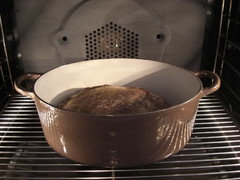
Here is a link that might be useful: Oatmeal Wheat Bread
mtnrdredux_gw
Original Author12 years agolast modified: 9 years agoRococogurl, that is one beauuuuuutiful loaf of bread.
mtnrdredux_gw
Original Author12 years agolast modified: 9 years agoWell, I started Wednesday night. I made the fruit water presoaker, the soaker, the biga, and then the dough! It could have been done a little sooner but I think no matter what it would take 2+ days...
Here she is my bouncing baby loaf ... and she is delish!
Here is a link that might be useful: Here's the recipe in case you 3 spare days!
sixtyohno
12 years agolast modified: 9 years agoThe no knead is easy and incredibly delicious. I sprinkle the bottom of the pan with corn meal and sprinkle a little on top of the bread too. The crust is the best. My bread comes out exactly like the photo every time. The problem is that we stand at the counter with some soft real butter and there goes the loaf.
mtnrdredux_gw
Original Author12 years agolast modified: 9 years agoRococogurl,
Your bread looks so wonderful. I was going to try the recipe next. But when I saw the photo of it in the link, it looks very ordinary.
How did you make your bread so gorgeous? Steam? A dusting of flour?
Frazestart
12 years agolast modified: 9 years agoI haven't baked bread in a while but for my next loaf, I intend to try this method. Open crumb, crackly crust and complex flavor, what's not to like?
Here is a link that might be useful: Jim Lahey�s bread
rococogurl
12 years agolast modified: 9 years agomtn, funny I was just going to say how beautiful your bread looked and glad to hear you got the taste right (but 3 days...)
No steam or flour with this one (both with my French baguettes but another story).
I use KA bread flour (better results than Hecker's) and preheat the Le Creuset with the lid in place for 45 minutes minimum at 450 on surround (I have a Euro convex oven) so the lid is burning hot as well (literally -- I set it on an old chopping block once and it burned the block). Over time I figured out to put the casserole on the bottom rack and put one rack up high that I slide the hot lid on rather than move it out.
After mixing and overnight rise I shape it and turn it seam down on one side of a cornmeal dusted linen or flour sack towl on a baking sheet. Found cornmeal better than flour which can stick to the cloth sometimes.
When it's ready to bake I literally roll the dough off the towel into the pot by lifting up on the towel to move it. It borders on a fling. Don't worry how it lands and don't try to adjust -- I've had mine off center, sticking to the side etc. It self-adjusts with the rise and the shape will be a bit different each time due to the roll in. I immediately cover pot and give it 30 mins covered. Then I uncover and slide the lid back on that upper rack. Usually it takes 20 mins more to get the good color.
Done, it releases very easily with tongs and pot is easy to clean. I let the pot cool down in the oven -- way too hot to mess with IMO.
Trust me, yours will look as good or better. I'd also suggest following recipe exactly the first few times till you get to know the dough as it's not the usual.
Waiting for photo!
mtnrdredux_gw
Original Author12 years agolast modified: 9 years agoI assume your Creuset is a regular Dutch oven?
That bread is so gorgeous. Do you make other breads in the same manner?
rococogurl
12 years agolast modified: 9 years agoFunny about that. Had it more than 25 years and used it twice until this bread. So glad I didn't throw it in one of the house sales.
I've always used an oven stone for the baguettes, French dinner rolls, pizzas, calzones and some pastries. Did levain years ago and it's a natural for the pot method as Tuscan bread would be with its thick crust though it's never dark. Just haven't had time to play around with my T&Ts yet but it will be a long winter. I expect some whole grain breads could bake nicely in the pot but those can be tricky re burning. I'd like to develop an Italian style whole wheat, which seems like a natural for this method, too. I'm a sour vs sweet with breads.
User
12 years agolast modified: 9 years agoSome how missed the saga of the bread baking. Gorgeous loaves of bread.
Something you might be interested in is using your own "wild yeast" to make breads. Yeast is naturally found on the grains. To promote its growth you mix equal parts of water and flour and each day you take out 1/2 and add back in the same amounts of fresh. In a week you have your own yeast culture. it is wonderful for rising your breads. I have been doing it for several years now.
The beauty of it is the rich sourdough taste...which you can control from very pronounced to no sense of it at all. Also you never again have to use commercial yeast.
I will attach a link to the person that has the best and most complete info on the net. Her formulas are fool proof. I have been baking all of our bread since 1978 and was glad to learn something new. I use it now for all of my breads. I also save all of the "discard" , the part you remove before you feed your starter and I add it to pizza crust and quick breads and waffles...whatever. No waste in my house :)
I also use iron pots for my baking. I don't do the Sullivan bread as I don't want to use lots of yeast and i like the taste that develops over time. I preheat my pots at 500 convection for 1 hr. I have my breads rising in cloth lined baskets. I place a piece of parchment over the basket and hold it tightly and turn the basket over. Bread is now right side up and on parchment. I quickly tear off all but the sling part I need to lower the bread into the pot and slash the loaves. I then lower them into the hot pot and spray a little water to aid the steam and place the hot lid back on and place back in the oven. I lower the temp to 460 and bake covered for 15 min and the remove hot lids and bake 20 min.
I have 2 pots. One is an antique iron pot that MIL gave me and one is a Le Creuset that i bought on sale at a Tuesday Morning , it was on the bottom shelf behind a lot of stuff and covered with dust...$100 ! It matches my kitchen and is Saffron...a color that you can't get anymore. Lucky me :)
I have never had a problem with the hot pots and transfers, lid removal , burning of bread etc. It is really a fool proof method. Also if you use a combo of rice flour and white flour and rub it into the cloth napkins that line the baskets the bread will never ever stick.
Oh also...if you look on The Fresh Loaf . a bakers blog , you will see lots of info on fruit water as a natural yeast . Raisins and apples are two that work quite well. There are very detailed instructions for how to grow your own. They have a search engine that is excellent and you can search "yeast fruit water".
in the pot:
out of the pot:
in the pot:
out of the pot:
cut loaf:
in basket:
slashed and ready for pot:
Here is a link that might be useful: Wild Yeast Blog
rococogurl
12 years agolast modified: 9 years agoGorgeous boules Caroline. I always enjoy seeing your breads.
User
12 years agolast modified: 9 years agothank you jane. I am going to have to try the longer version of the bread that mntrd made. I will have to leave out the flax...( no comment :) ) but otherwise it sounds wonderful and hers looks great.
I hope you will post more of what you are making these long winter days up country. c
mtnrdredux_gw
Original Author12 years agolast modified: 9 years agoHi Trailrunner,
The bread that I made did use a natural yeast, from raisin and flax seed water. It required making two pre soakers and a biga before you made the dough, hence the 3 days required!
I did find the Fresh Loaf but am also becoming a Peter Reinhart groupie. My goal was to try to copy the bread we buy at our organic baker, and the complex recipe I linked to did exactly that. This has been the house staple bread since we moved to CT, and now we can make it ourselves.
I was definitely going to get myself a couche and some baskets to form shapes. I dont have a Creuset (that's a tough line for colorphobes like me) but I have a Staub that would work. I am not excited about 500 degrees .. yikes.
My kids like sourdough too, and I think they will be fascinated by that starter too. Your loaves are beautiful too!
Thanks for all the advice.
mtnrdredux_gw
Original Author12 years agolast modified: 9 years agothanks for the link Trailrunner
I am about to become a mad scientist baker ...
User
12 years agolast modified: 9 years agomnt...when you read about the fruit starter you will see that it is different than what you made. Yours really is just a soaker and wouldn't have risen the bread all alone. The fruit starters need a good week or more to get a yeast that will rise bread. It is very complicated, at least lengthy, and a lot more tending, thus I have yet to do it. The flour/water is quite easy and in 10 days or so it will be strong enough to rise any loaf you wish to try from Wild Yeast's formulas. I urge you to follow her formulas before you try any of PR's. He has a lot of errors in his formulas and she has none. Until you are used to how the formulas are put together and percentages you could end up with doorstops not bread LOL.
Let me know how it goes...I look forward to your mad scientist baking :) c
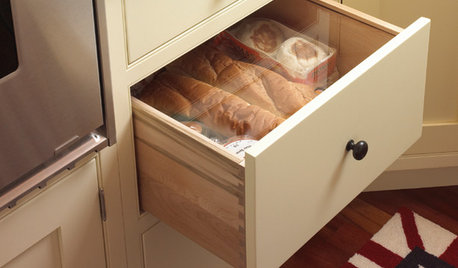






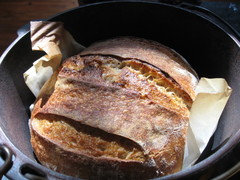
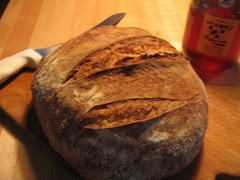

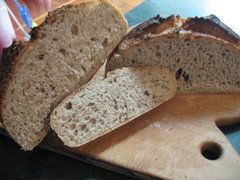
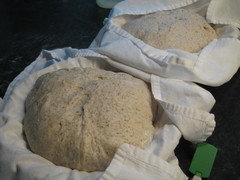
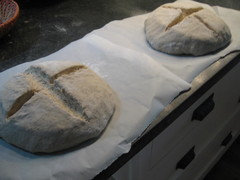



rhome410